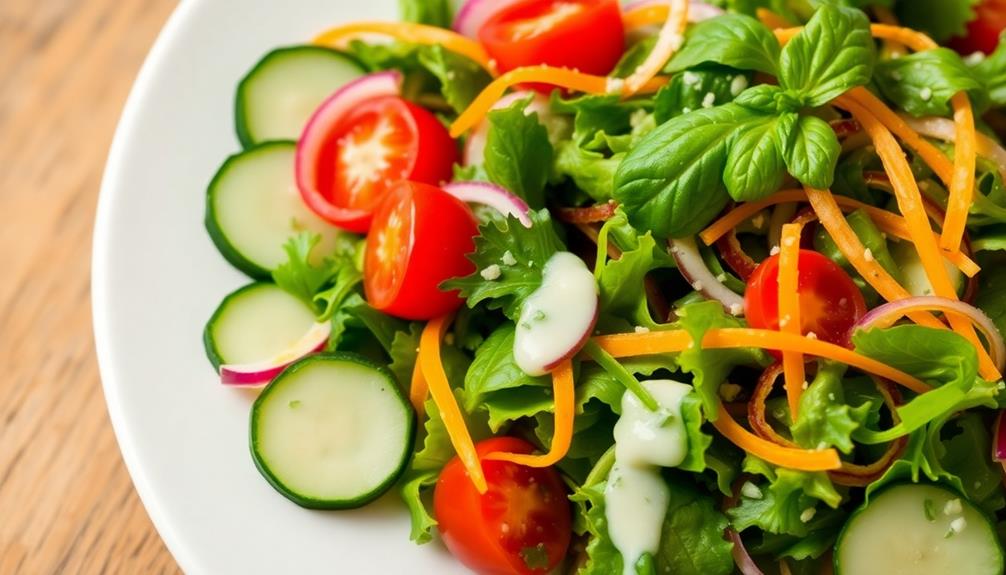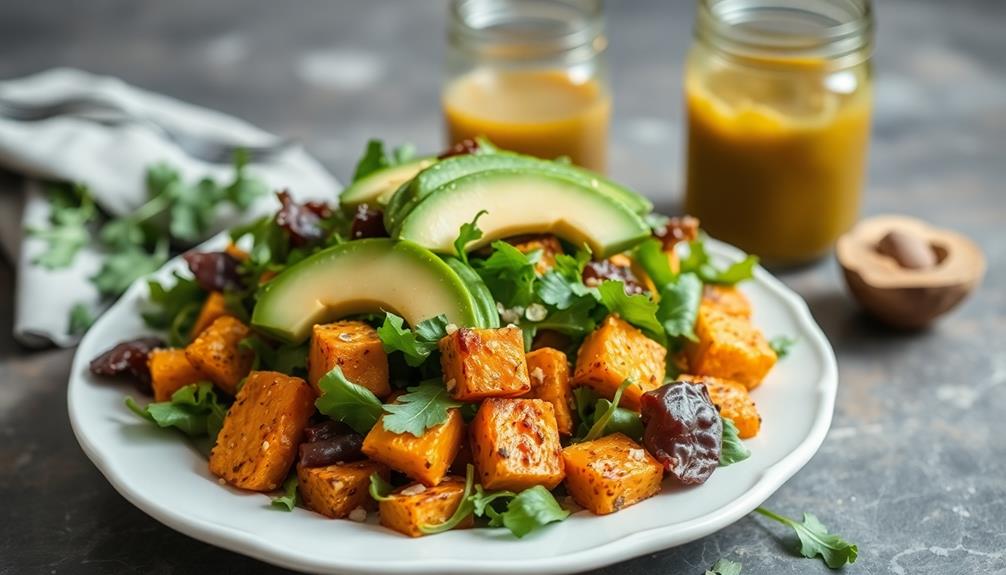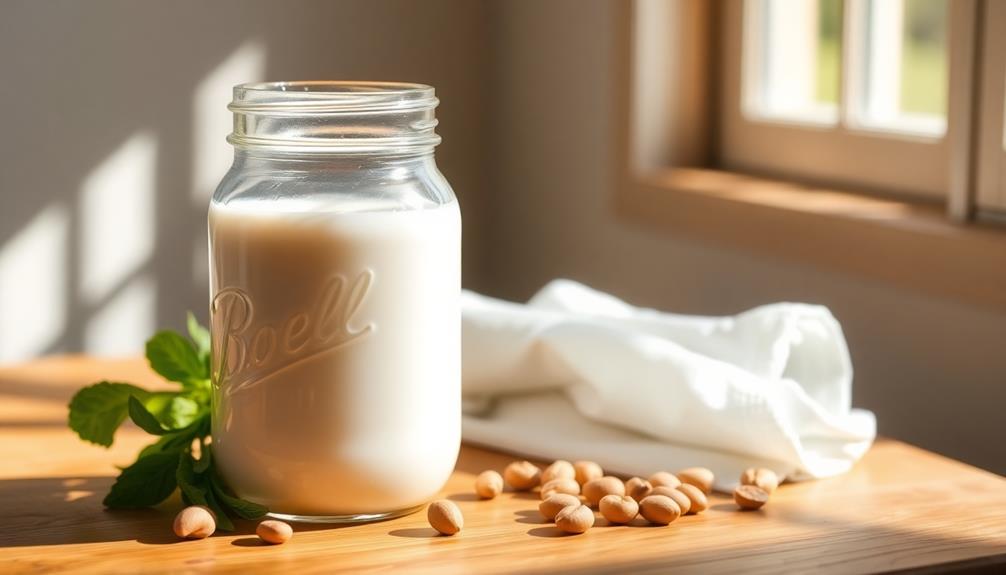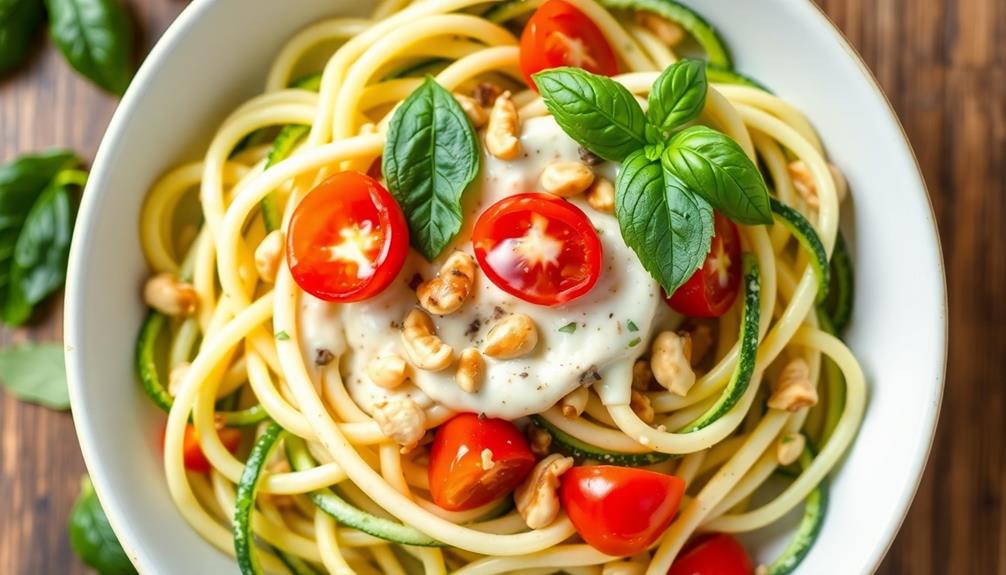Balancing nutrition on a low-FODMAP diet takes some planning, but it's doable. The key is to focus on nutrient-dense, low-FODMAP foods that provide essential vitamins, minerals, and fiber. Build meals around lean proteins like chicken, plus veggies like green beans, zucchini, and bell peppers. Season with herbs, spices, and low-FODMAP condiments to add flavor without triggering symptoms. Remember to listen to your body's cues – you may find you can gradually reintroduce some higher-FODMAP foods in moderation. With a little creativity, you can maintain a balanced, nourishing diet while managing your digestive health. Keep reading to learn more about low-FODMAP cooking techniques.
Key Takeaways
- Emphasize a balanced diet rich in essential nutrients, including protein, fiber, vitamins, and minerals, to meet dietary needs while following the low-FODMAP approach.
- Incorporate a variety of low-FODMAP vegetables, fruits, and whole grains to ensure adequate intake of carbohydrates, vitamins, and minerals.
- Plan meals that include lean protein sources, such as chicken or fish, to support energy levels and muscle maintenance.
- Utilize low-FODMAP herbs and spices to enhance flavor and enjoyment, avoiding the need for high-FODMAP seasonings.
- Monitor portion sizes and gradually reintroduce tolerated high-FODMAP foods to achieve a sustainable, balanced low-FODMAP diet for long-term gut health.
History
The low-FODMAP diet was, in large part, developed by researchers at Monash University in Australia. They discovered that certain carbohydrates, known as FODMAPs, can trigger digestive issues in people with conditions like irritable bowel syndrome (IBS).
The term "FODMAP" stands for fermentable oligosaccharides, disaccharides, monosaccharides, and polyols – these are the types of carbohydrates that can be problematic for some.
The low-FODMAP diet aims to identify and eliminate high-FODMAP foods, allowing the gut to heal and reducing symptoms like bloating, gas, and abdominal pain. It's become a popular approach for managing IBS and other digestive disorders.
While it was initially created for research purposes, the low-FODMAP diet has since gained widespread recognition as an effective way to improve gut health and find dietary relief. The low-FODMAP diet involves eliminating or limiting certain types of carbohydrates that can be difficult for some people to digest. These carbohydrates, known as FODMAPs, are found in a wide variety of foods and can exacerbate symptoms such as bloating, gas, and stomach pain for individuals with irritable bowel syndrome (IBS). By following a low-FODMAP diet, individuals can identify and avoid hidden FODMAP ingredients that may be contributing to their gastrointestinal discomfort, leading to improved overall gut health and dietary relief.
Today, it's used by healthcare professionals around the world to help patients find the right balance of nutrition while avoiding triggering foods.
Recipe
Low-FODMAP diets can be challenging when it comes to balancing nutrition. This recipe for a hearty, low-FODMAP meal is designed to provide a satisfying and well-rounded dining experience. The key ingredients are carefully selected to ensure the dish is both flavorful and gut-friendly. Incorporating protein-rich options like chicken can help maintain energy levels throughout the day, while vegetables provide essential vitamins and minerals, making this dish a great fit for those seeking low carb high protein breakfast ideas.
This recipe features a savory chicken and vegetable stir-fry, which is a great option for those following a low-FODMAP diet. The dish is packed with lean protein, fiber, and essential vitamins and minerals, making it a nutritious and satisfying choice.
- 4 boneless, skinless chicken breasts, cut into 1-inch pieces
- 2 cups thinly sliced green beans
- 1 cup diced zucchini
- 1 cup sliced bell peppers
- 2 tablespoons olive oil
- 2 tablespoons low-FODMAP soy sauce or tamari
- 1 teaspoon ground ginger
- 1/4 teaspoon black pepper
In a large skillet or wok, heat the olive oil over medium-high heat. Add the chicken and stir-fry until it's cooked through, approximately 6-8 minutes.
Add the green beans, zucchini, and bell peppers, and continue to stir-fry for an additional 4-5 minutes, or until the vegetables are tender-crisp. Stir in the low-FODMAP soy sauce or tamari and ground ginger, and season with black pepper to taste.
This dish is best served immediately, while the vegetables are still vibrant and the chicken is juicy and flavorful.
Remember to avoid high-FODMAP ingredients like garlic, onions, or certain fruits and vegetables that may trigger digestive discomfort. Enjoy this balanced, low-FODMAP meal as part of a healthy, gut-friendly diet.
Cooking Steps
Start by dicing the onions and garlic.
Next, sauté the vegetables in a low-FODMAP oil like olive or avocado oil.
Then, add the tomatoes, stock, and let it all simmer.
Step 1. Dice Onions and Garlic
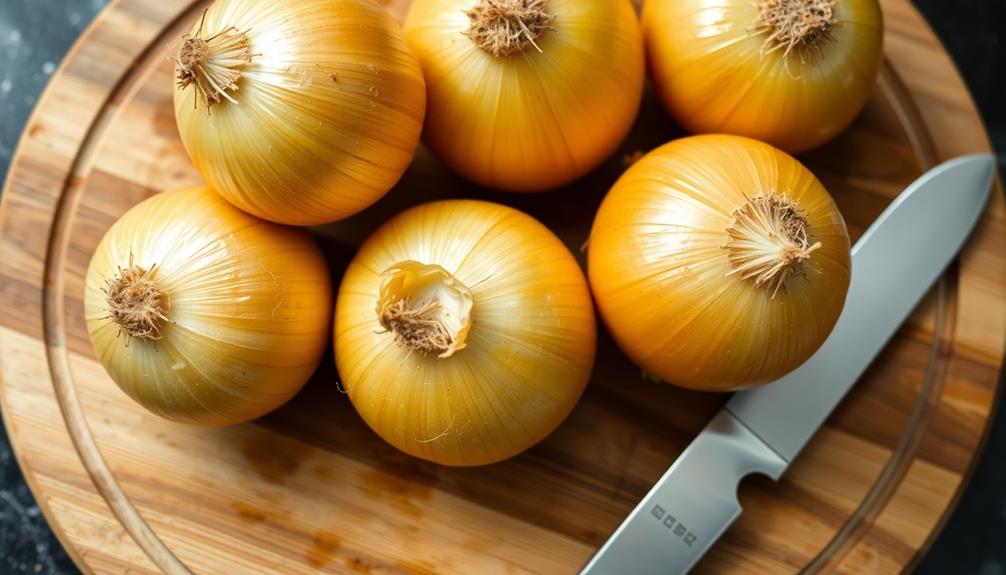
For low-FODMAP cooking, begin by dicing onions and garlic. You'll want to do this carefully and precisely, as these ingredients can be tricky on a restricted diet.
First, peel the onions and garlic cloves. Lay them on a cutting board and, using a sharp knife, slice the onions in half from root to stem. Then, make thin, even slices across the onion halves.
As for the garlic, mince the cloves by rocking your knife back and forth over them, chopping them into tiny pieces. Go slowly and pay attention to avoid cutting yourself.
Once your onions and garlic are diced, you're ready to start cooking. The key is to use just the right amounts, as too much onion or garlic can quickly upset the low-FODMAP balance.
With a little practice, you'll get the proportions just right, allowing you to enjoy the flavors without any tummy troubles.
Step 2. Sauté Vegetables in Low-Fodmap Oil

With your onions and garlic all prepped, you can now sauté the vegetables in a low-FODMAP oil. Choose an oil that's suitable, like olive, avocado, or coconut oil.
Heat the oil in a skillet over medium heat, then add your chopped veggies. Sauté them, stirring occasionally, until they're tender and lightly browned. This usually takes about 5-7 minutes. Be sure to keep an eye on them, as you don't want them to burn.
Once the vegetables are cooked, you can season them with salt, pepper, and any other low-FODMAP herbs or spices you'd like. Fresh thyme, rosemary, or basil work well.
The key is to create flavorful, nourishing side dishes that fit within your low-FODMAP diet. Sautéing is a quick and easy way to prepare a variety of vegetables, from leafy greens to colorful bell peppers.
Enjoy your tasty, low-FODMAP sautéed veggies!
Step 3. Add Tomatoes
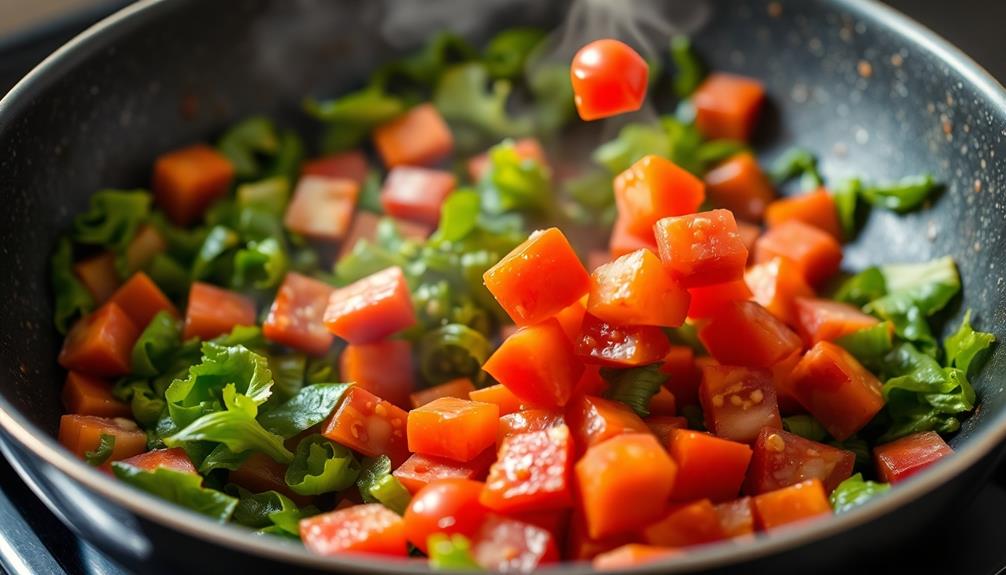
After sautéing the other vegetables, you can now add fresh or canned tomatoes to the skillet.
Tomatoes are a low-FODMAP ingredient that can add a delicious pop of flavor and extra nutrition to your dish. They're also rich in vitamins A and C, which can support overall health and well-being, making them an excellent addition to your meals for optimal health benefits.
You can use diced, crushed, or whole peeled tomatoes, depending on your preference. Be sure to choose a low-FODMAP variety, as some tomato products may contain high-FODMAP ingredients like garlic or onion.
Add the tomatoes to the skillet and stir to combine. Let the mixture simmer for a few minutes, allowing the flavors to meld. The tomatoes will release their juices, creating a sauce-like consistency.
If the mixture seems too thick, you can add a splash of low-FODMAP broth or water to thin it out. Season with salt, pepper, and any other low-FODMAP herbs or spices you enjoy.
The tomatoes will add a vibrant red color and a burst of tangy, slightly sweet flavor to your sautéed veggies.
Step 4. Add Stock and Simmer

Next, you'll want to add a flavorful low-FODMAP stock to the sautéed vegetables. This is a crucial step to create a delicious and nourishing base for your dish.
Choose a vegetable or chicken stock that's free of high-FODMAP ingredients like onions or garlic. Gently pour the stock into the pan, making sure to scrape up any browned bits from the vegetables – that's where a lot of the flavor comes from.
Now, let the mixture simmer for 10-15 minutes. This allows the flavors to meld and the vegetables to become tender.
Keep an eye on it, stirring occasionally, and add a bit more stock if it starts to look too dry. The simmering process will also help concentrate the flavors, so your final dish will be rich and satisfying.
Be patient – this step is well worth the wait! Once the veggies are nice and soft, you're ready to move on to the next part of the recipe.
Step 5. Add Herbs and Seasonings

Now that the base of your dish has simmered, it's time to add some herbs and seasonings to really make the flavors pop. This is where you can get creative and experiment with different flavor combinations.
Start by adding a pinch or two of your favorite dried herbs, such as oregano, basil, or thyme. These will infuse the dish with aromatic notes that complement the other ingredients. Additionally, incorporating ingredients like chia seeds can enhance the nutritional profile of your meal, providing nutritional benefits such as fiber that aids digestion.
Next, consider using fresh herbs if you have them on hand. Chopped parsley, cilantro, or rosemary can brighten up the dish and add a lovely freshness. Just be sure to add them towards the end of the cooking process to preserve their flavor and vibrant color.
Don't forget about spices, either! A dash of smoked paprika, cumin, or chili powder can lend a lovely depth of flavor, while a sprinkle of salt and pepper will help balance the overall taste.
Taste as you go, adjusting the seasonings until the flavors are just right.
Final Thoughts
Ultimately, maintaining a balanced diet while navigating the low-FODMAP lifestyle requires thoughtful planning and flexibility.
It's important to remember that the low-FODMAP diet isn't a long-term solution, but rather a temporary tool to help manage digestive symptoms. Once you've identified your trigger foods, you can slowly reintroduce them back into your diet in moderation. This process allows you to find the right balance of foods that work best for your body.
Throughout this journey, don't be afraid to experiment with new recipes and ingredients. Herbs and spices can be great ways to add flavor without upsetting your stomach.
Additionally, be mindful of your portion sizes and listen to your body's cues. With a little creativity and persistence, you can maintain a nutritious, low-FODMAP diet that supports your overall health and well-being.
Frequently Asked Questions
How Can I Meet My Daily Nutrient Requirements on a Low-Fodmap Diet?
To meet your daily nutrient needs on a low-FODMAP diet, focus on incorporating a variety of low-FODMAP foods like leafy greens, lean proteins, and lactose-free dairy. Supplement with vitamins and minerals if necessary to ensure you're getting all the essential nutrients.
What Are Some Common High-Fodmap Foods I Should Avoid?
You'll want to steer clear of high-FODMAP foods like garlic, onions, wheat, beans, lentils, and dairy products. These can trigger digestive issues for those following a low-FODMAP diet. Focus on low-FODMAP alternatives to meet your nutritional needs.
Can I Still Eat My Favorite Foods on a Low-Fodmap Diet?
You can still enjoy your favorite foods on a low-FODMAP diet, but you'll need to make some modifications. Many high-FODMAP ingredients can be swapped for low-FODMAP alternatives to satisfy your cravings while managing your symptoms.
How Do I Ensure I'm Getting Enough Fiber on a Low-Fodmap Diet?
You can still get enough fiber on a low-FODMAP diet by focusing on low-FODMAP fiber sources like gluten-free oats, chia seeds, flaxseeds, and vegetables like spinach, kale, and carrots. Be mindful of portion sizes to avoid exceeding your FODMAP limits.
Are There Any Supplements I Should Consider Taking on a Low-Fodmap Diet?
You may want to consider taking a probiotic supplement on a low-FODMAP diet. This can help support gut health and digestion. Additionally, a fiber supplement like psyllium husk can help boost your fiber intake.
